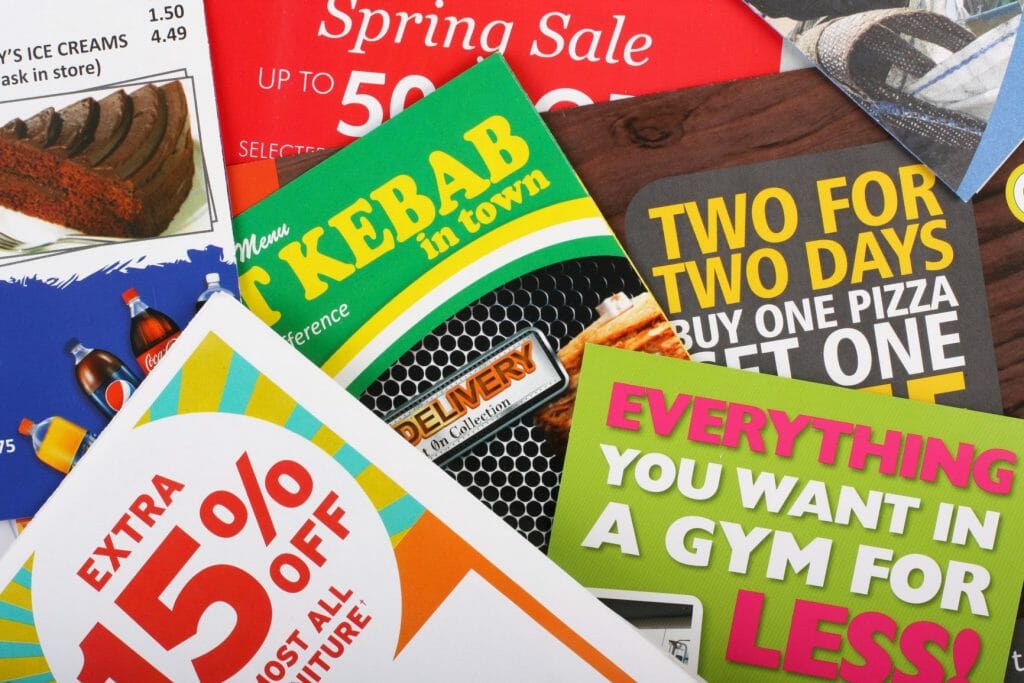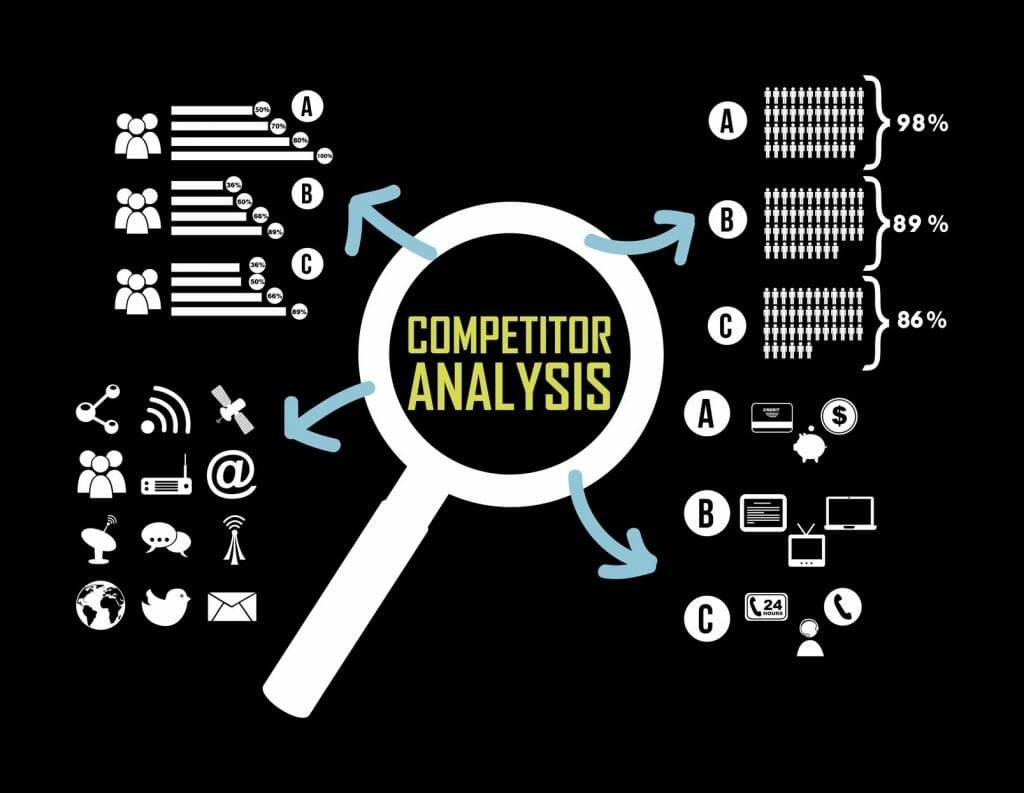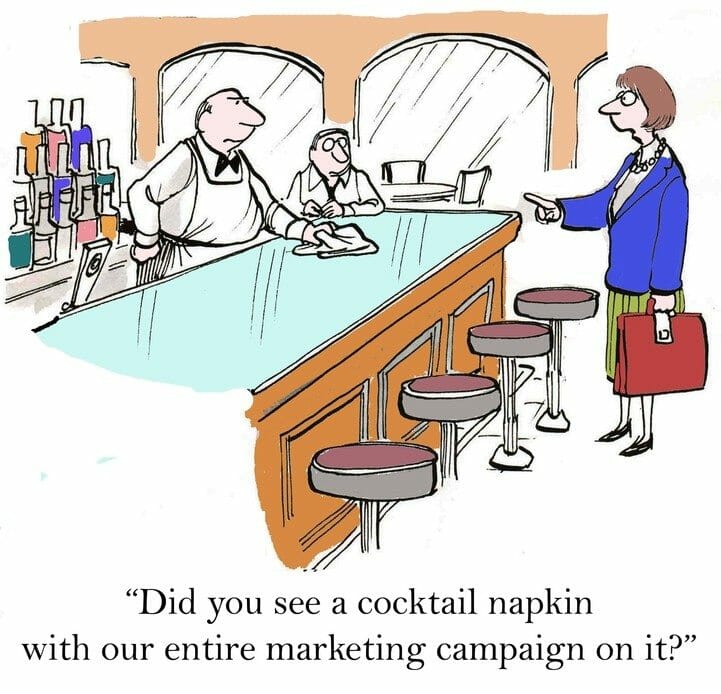Section I: Planning Your High Response Direct Mail Campaign
Chapter 1: Direct Mail Basics
What is Direct Mail?
In its most simplified state, direct mail is marketing through the US Postal Service. This includes a wide variety of marketing materials such as sales letters, postcards, brochures and catalogs. A direct mail campaign is used by businesses and corporations to target the individuals who are most likely to take advantage of a mailed offer. A great direct mail campaign can help companies maximize their marketing dollars by only mailing to the most highly probable prospects and sending nothing to those unlikely to be interested.
As corporations have long known, direct mail marketing is a highly profitable marketing channel that, when executed properly, delivers great returns and high response rates. Whether you’re looking to reach out to your existing clients or seek new customers, direct mail is a proven way to reach the exact person who has been looking for what you have to offer. This guide aims to help you take full advantage of direct mail and optimize your direct mail response rate.
Direct mail is a lucrative form of marketing for businesses advertising to other businesses as well as customers. It allows companies to target decision makers directly and get a piece of mail into their hands, radically increasing the possibility of making a sale.
Does Direct Mail Still Work in the Digital Age?
Digital marketing is all the rage but, contrary to popular opinion, direct mail is not dead. It’s thriving. How many people actually read their direct mail? According to 2013 statistics from the Direct Mail Association (DMA) , 65% of consumers across all ages have bought something from a direct mail piece. That’s a lot of people!

Although the evidence is there, is it possible for direct mail to outperform digital marketing? Actually, according to the DMA , the average response rate for direct mail marketing was 4.4% in 2012. This response rate includes both business-to-consumer (B2C) and business-to-business (B2B) marketing . This is much greater compared to electronic mailing which garnered an average response rate of only 0.12% in the same year. Also, according to a USPS study, households that earn $150,000 or more per year respond to an average of 2.2 pieces of direct mail each week. That’s more than 700 each year (on average) for this demographic.

Regardless of these facts, perhaps you still have your doubts. With design, printing and postage, doesn’t direct mail cost a lot more than digital marketing? The same organization has debunked this myth as well. Through the DMA’s research, it has become clear that direct mail marketing’s cost per lead is about the same as email and pay-per-click, and significantly less than telemarketing.
The Print on Demand Institute (PODI) has found that direct mail response rates can be even higher than these other forms of marketing when direct and digital marketing are integrated with increased personalization like PURLs and personalized landing pages. (More on this in later chapters.)
Types of Direct Mail and How to Choose Which Format is Right for Your Business
As you begin planning for your business’s next direct marketing campaign, you’re going to want to consider all of your options. When choosing which direct mail format you are going to use for your next campaign, approach the choice with an open mind because each type of mail has its own distinct benefits.

Postcards
Often the most economical, postcards are very effective in direct mail. The prospects’ addresses will appear on the front and the offer is usually on the back. A postcard would be perfect for your business’s direct mail marketing if you want to arouse interest in an offer that can quickly entice the viewer to take further action like visit your website or call your office. According to a USPS study, 52% of recipients read postcards.
Standard Letters
Typically with the highest response rate, these pieces of direct mail often include a sales letter folded in half that is directed to the prospect. Personalization is what makes these so effective. With a letter, you also have the envelope to personalize. (Read more about this process later.)
Self-Mailers
A self-mailer is similar to a postcard and can be mailed without an envelope or any wrapping. It is usually folded in half and sealed. Using a self-mailer can keep your mailing and printing costs down.
Catalogs
With a long history in direct mail, catalogs compile a number of products and offers for a single customer to browse through. If you want to tell your prospect about everything you offer, or at least a wide selection, a catalog could fulfill your need perfectly. If the prospect needs what you’re selling, they will have all the information right in front of them and be ready to buy.
Chapter 2: Identifying Your Business’s Target Audience to Maximize Your Response Rate
Conducting Effective Market Research
Any great direct mail campaign always begins and ends with research. Right from the start, begin learning everything you can about the market, your industry, and any and all competition. Plus, get to know any customers you’ve already identified. Start by diving into research other people have already conducted and read the latest news stories and blogs. This free information is very insightful and saves your company money.

Sometimes it’s advisable for your company to take an even deeper look into the market in order to identify your business’s target audience and customer. In this case, invest in a market research company to help you develop market surveys, focus groups and more. Always work with a researcher you trust and help them get to know your business by bringing them up to speed. By obtaining these valuable sources of primary research, you’ll be able to get direct answers to your market research questions. (Learn more about creating a marketing survey below.)
Identify the Demographics, Psychographics and Trends of Your Audience
Now that you’ve gathered lots of research data, it’s time for you to break it down and create a customer profile. This in-depth description of your ideal customer will likely include demographic and psychographic information.
Demographics indicate factors like age, gender, marital status, income and ethnic background.
Psychographics include information that helps differentiate your customer’s psychological profile from others like hobbies, interests, values, lifestyle and behaviors.

It’s not enough for you to just know who your target audience is, but you also need to know where they spend their time and what they like. Find out which blogs they subscribe to, which websites they share with friends and which social networks they most frequently post on. Are they addicted to email? Or do they always try the latest app?
How to Create an Effective Market Survey and Get Better Response Rates
The right survey will deliver your business invaluable insights into your market and target audience. It’s always advisable to conduct a market survey before making any large changes in your business. Always make sure you have a clear objective when designing a survey, as this will help you stay on track. With every survey, you’ll also need to determine the sample size. Larger sample sizes deliver more accurate research. Also, try to keep yours as diverse as possible to get more accurate results.

It’s important to remember that a survey doesn’t tell you anything unless you can analyze the data. You’ll need access to computer software in order to process the results accurately. In order to maximize effectiveness, it may be wise to hire a research company to assist you in implementing your survey.
As you create a market survey, the following tips will help you get better response rates:
-Keep it short and focused
-Pre-test the survey with just a few people to gauge results
-Tell your prospects the reason for the survey
-Keep all rating systems consistent
Chapter 3: How to Target Your Ideal Customer for a Higher Direct Mail Response Rate
Analyze Your Market Research and Your Competition’s Marketing
As mentioned in the last chapter, market research and survey results do not mean anything unless you are able to analyze them and extract useful bits of information. Before you get overwhelmed with all the of data you have collected, start by reviewing your research goals.

Your market research may consist of quantitative data like ratings, rankings, and yeses or no’s, or it might be qualitative data like verbal answers to interview questions or written responses on surveys. For quantitative data, begin to tabulate your responses. For qualitative data, look for overarching themes and similarities. With the information organized, now must put it into perspective. Start to compare your market research results [http://managementhelp.org/businessresearch/analysis.htm ] to the results that you had expected.
When it comes to getting higher response rates from your direct mail marketing, it’s imperative to analyze your competition’s marketing. Start by isolating your direct competitors and then collecting their marketing materials. Sign up for their direct mail campaigns so you can see what they’re doing exactly and analyze whether it works or not.

The goal of your competitor analysis is to look for consistencies across their campaigns. Look at the headlines and taglines as well as the message behind the copy in the direct mail. This information will show you how they are positioning their product or service to meet the needs of the customers. When you analyze your competition’s marketing thoroughly, you can determine where openings are and where you can go after a larger share of the market.
Acquiring Mailing Lists
Now that you’ve defined your customer profile and have analyzed the market, knowing what your competitors are doing, you need to gain access to the names and addresses of those people in your target audience. The fact that direct mail list vendors have been building and working on their lists for decades is a strong reason to consider acquiring one. A direct mail list from a reputable vendor gives you the opportunity to target and reach your ideal customer.
The goal of your competitor analysis is to look for consistencies across their campaigns. Look at the headlines and taglines as well as the message behind the copy in the direct mail. This information will show you how they are positioning their product or service to meet the needs of the customers. When you analyze your competition’s marketing thoroughly, you can determine where openings are and where you can go after a larger share of the market.
Acquiring Mailing Lists
Now that you’ve defined your customer profile and have analyzed the market, knowing what your competitors are doing, you need to gain access to the names and addresses of those people in your target audience. The fact that direct mail list vendors have been building and working on their lists for decades is a strong reason to consider acquiring one. A direct mail list from a reputable vendor gives you the opportunity to target and reach your ideal customer.

If your business specializes in B2B marketing, stop renting lists from trade associations and list owners. Instead, find a list broker who will help you find exactly what you need. You’ll pay no research fees since you only pay if you rent the list and the list broker will coordinate directly with the list owner for you. For your next B2B direct mail campaign, call a list broker and ask for their recommendations. You might be surprised when they recommend something other than the standard trade publication. When you acquire a mailing list , you must test it in order to understand the response rate. Although two lists might seem almost identical, there is no guarantee that the response rates will be the same.
Generating Your Own Direct Mail Marketing List
If you don’t have a list of targeted people created by your business, now is the time to create it. You will want to include customers who have already responded to your other campaigns or who have bought your products or services previously. Also, be sure to include any and all former customers because you might be able to win them back.
As you start generating your own direct mail marketing list, remember to keep the target customer of this campaign in the front of your mind. You are not looking to send your direct mail out to everyone. It must be targeted. If you want an increased direct mail response rate, keep your business’s eyes on the target.
Creating your own mailing list may take some time. Start by giving people incentives to provide you with their mailing addresses. Perhaps you can run a contest or sweepstakes. Or, perhaps they would like to sign up for your monthly newsletter. Make sure it’s easy for them to provide you with their information. Perhaps an online form that asks for their address would work well, or ask them to provide it in an email survey. As you begin to collect names and addresses, store them in a database program that makes it easy to sort and rearrange the list as needed.
Chapter 4: Calculating Your Direct Mail Marketing ROI
Estimate Your Costs Before You Create the Direct Mail Campaign
Estimating how much it costs to run a direct mail campaign is a necessary step in the planning process. In order to do this, you’re going to need to know some numbers and run them through a calculation. Take out a piece of paper, a pen and your calculator. Write down each of the numbers below and run them through the equations to determine your ROI.
-Campaign Audience Size (How many people are you sending the piece of direct mail to?)
-Campaign Costs (What is the total cost of the direct marketing campaign?)
-Expected Response Rate (What response rate do you expect to receive?)
-Conversion Rate (What percent of responders do you expect will become customers and buy from you?)
-Average Buyer Purchase (What will the average customer spend?)

Use the following equations to calculate your Direct Mail campaign ROI:
-Cost per Mailing = Campaign Cost / Campaign Audience Size
-Number of Responders = Campaign Size X Expected Response Rate
-Number of Buyers = Number of Responders X Conversion Rate
-Revenue Generated = Average Buyer Purchase X Number of Buyers
-Profit = Revenue Generated – Campaign Costs
-Cost per Responder = Campaign Cost / Number of Responders
-Cost per Buyer = Campaign Cost / Number of Buyers
-ROI = Profit / Campaign Cost

Prepare for Your Direct Mail Response Tracking and Follow Up
Nothing is worse than when a company sends out a direct mail campaign only to not be prepared when the responses start rolling in. If a company misses a response, they (most likely) lost the sale. You need to be prepared to collect data on responses and sales. A great way to track responses is to use a dedicated phone number for each of your direct mail campaigns. You can also create a unique domain name or have Personalized URLs or PURLs for each prospect.
As calls start coming in, you’re going to want to keep track of the Cost per Responder or CPR. This will tell you how many people actually responded to your direct mail campaign. (See above how to calculate CPR). You should also consider coding your response vehicle before sending out the mailing. Coding provides an easy way for you to know which direct mail campaign and piece of mail the prospect is responding to. With the right response tracking, you can determine which campaigns are most effective.
When calls start coming in from your direct mail campaign, you need to be prepared to handle fulfillment and follow up. You need to be prepared to provide the offer you have advertised in your direct mail campaign. Are they requesting more information? Are they calling to buy a product? Whatever action your prospects are taking from your direct mail campaign, you need to be prepared to handle it without delay. You may need to work with a fulfillment house or a call center in order to properly follow up and handle the direct mail response rate.

Section II: Creating Direct Mail Materials That Increase Response Rate
Chapter 5: 9 Tips to Design Your Direct Mail to Stand Out
Every day, marketers and businesses send out direct mail campaigns. Unfortunately, not every piece of mail is read. These 9 tips will help you design your direct mail to stand out and beat the bin with direct mail.
- Envelope Design
If your piece of mail looks boring or common, it will probably get thrown away before it is even read – and if the person you’re mailing to has an assistant sort their mail, you’re going to have to work extra hard. Start by making your envelope look important or unusual. If your budget allows, try a padded envelope as this implies value.

- Go 3-D
If you want to really make your direct mail stand out and increase your response rates, try using a 3-dimensional design. Boxes are very unlikely to get thrown out and will almost always be opened. Who doesn’t like to get a box or package in the mail? Also, consider doing something unique like sending a tube or another odd shape. These will most certainly get you noticed. (Although, they will increase production and shipping costs.)

- Personalize
If your mail is addressed to “Dear Valued Prospect” or something similar, you’re fighting an uphill battle. Every chance you can to personalize the direct mail campaign improves our prospect’s likelihood of reading it and your likelihood to get a response. Try addressing it to the recipients by using their names, and maybe even choosing a font that looks hand written. Perhaps you could sign the letters yourself! Personalized URLs are also a highly effective method to getting better responses and standing out.

- Targeted Fonts and Colors
Because you did your market research, know your target customer’s profile and have seen your competitors’ direct mail campaigns, you should have a clear idea about which types of fonts and colors would speak best to your audience. Unfortunately, colors and fonts can quickly alienate your audience if not chosen carefully – and get your direct mail thrown into the trash. Always put careful thought into the font and color scheme. Also, consider the influence the psychology of color plays on your target audience.

- Try Unique Materials
Take a look at your desk. You are likely gazing at a lot of standard, white #10 envelopes. If you want to break out of the mold completely and really stand out, print your direct mail on some kind of unique material. Perhaps metal, wood or plastic might really get your marketing into the hands of decision makers.
- Seize the Postage Side Space
Too often businesses and markets miss the opportunity to use the postage side space of their self-mailer and postcards. Studies have shown that most direct mail pieces are delivered postage side up. This is your opportunity to give your prospect a teaser and a reason to flip your postcard over or open it and read more. Make sure, however, that your creativity is compliant with the USPS.
- Choose Color over Black & White
Almost without question, a colorful, well-designed piece of mail is going to garner more attention than an ordinary, plain document. Use effects if they match the concept and utilize color in a way that makes your piece stand out from the rest while not being too overbearing to your prospect.

- Emphasize Keywords
When you’re trying to get your direct mail noticed, don’t hesitate to point out what makes your offer better. Emphasize things like “Free”, “Discount”, “Sale” or “Prize.” Make these words bold, underlined or in color and you will surely draw people’s eyes and their interest to the mail piece.
- Keep Text Scanable
Avoid writing long blocks of text in any direct mail campaign or letter. Instead, use headlines and subheads to allow people to easily scan the advertisement so that they can gather as much information as possible in the shortest amount of time. Once you have their interest, they’ll be more likely to read in-depth and learn the details.
Chapter 6: Crafting High-Value, Creative Copy
Writing a Headline that Increases Your Direct Mail Response Rate
The first step to writing cost-effective creative copy in your direct mail sales letter or other marketing piece that gets results is to make your headline count. The headline is the first piece of copy that your target audience is going to read. Make sure it gets their attention.
To make your headline extremely effective, find the answers to these questions:
-What desire or need is driving your target audience?
-What solution does your product or service offer to fill this need or desire?
Armed with the answers to these two important questions, start by writing a few headlines. If, for example, your business sells accounting software, don’t make your headline something like, “Want Better Accounting Software?” Instead, try something like, “We Help You Keep All Your Accounts Organized While Saving You Valuable Time and Money.”
As you can see in our example, the second headline clearly outlines the benefit or solution to the problem your prospect has (i.e. disorganized accounts). It also offers the benefit of saving them money and time. This target market would probably be interested in a solution like that and be more likely to read further because of that connection.
Opening Your Sales Letter with Power
The sales letter has been around for more than 100 years and, in our digital age, it is still an effective direct mail method. When you or your copywriter writes the sales letter, always write it person-to-person. This means writing as if your audience is “you” and the writer is “I.” Since you sent this letter directly to the prospect and they have now opened up the letter, you have their attention for a few very valuable minutes. Write the letter as if you’re speaking to a friend and don’t be afraid to use contractions like “isn’t” or “you’re” in the letter. That’s how we speak. Keep sentences short and direct.

Besides the headline, you’re first paragraph needs to be the strongest part of your letter. People are busy. Now that they’re busy reading your sales letter, you must give it your best shot from the top because your prospects might not finish the letter completely. Some experts recommend that you quickly move to emphasizing the problem your prospect is experiencing to clearly show how your product or service is the logical solution.
As you continue to write your sales letter, make sure to break up long pieces of text. Make it scannable with bullet points and frequent headers. Use bold fonts and underlines to emphasize key phrases. Use the layout of your letter to enhance the experience and make it even easier for your prospect to decide if this product or service is right for him or her.
Balancing Benefits, Proofs and Promises in Your Sales Letter
As your prospect reads deeper into your direct mail sales letter, you need to keep their attention and interest. You do this by demonstrating your product or service’s benefits, indicating proof as to how and why it works, and restating your promise.
The majority of your letter should focus on the benefits of your product. Features of a product don’t sell but benefits and solutions do. In as many ways as necessary, restate your business’s unique selling proposition in writing throughout the letter. Make sure that your prospect knows exactly what they will gain by purchasing from you and why your product or service is better than anyone else’s.

In order to gain the trust of your prospect, you will most likely need to include proof that your product or service actually delivers the benefits you’ve promised. You can do this through quoting respected experts, gaining a celebrity endorser or doctor, or utilizing good old-fashioned testimonials. As you provide clear proof that your product or service works, you need to seamlessly interweave your promise into it.

Writing an effective sales letter is an art that has been perfected over its 100-year history. So, implementing these best practices will deliver proven results that have passed decades of tests. If you want to ensure that you have the best sales letter, consider finding a copywriter with proven experience in direct mail copywriting.
Present Your Offer and Repeat
Even if you’ve written the perfect headline and the best possible sales letter, your direct mail response rate may be low if you don’t make a strong offer. People buy solutions, not products or services. In the eyes of your prospect, there is a huge difference between buying from you and accepting your offer. For example, people don’t buy financial services; they accept an offer to save 30% when they subscribe for accounting software for an entire year.

When you first present your offer to your prospects in your letter, make sure the benefits that of your offer are mentioned. This can enhance the offer greatly. If you’re an online university looking for new students, your offer might be something like, “For less than 25% of the cost of the average college education, you can earn a degree from our world-renown professors from the comfort of your own home.” Soak your offer in benefits and make sure your prospects clearly see why your offer is better than some alternative.
Even though you represent a reputable company, people still fear getting cheated or ripped off. The simplest way to defeat this resistance is to offer a guarantee. A guarantee can go a long way to getting people to try your product or service – especially if there is little or no risk. The free trial is perhaps the best of its type because people end up trying it and often keep going after the trial ends. Other guarantees could be “try it for 30 days risk free and, if you don’t like it, send it back” or “a money-back guarantee.” When people know that they can always change their mind, they will be more likely to accept your offer.
Include Your Call to Action
Your call to action should be clear and direct. It’s another important element to crafting copy that gives you a higher direct mail response rate. At the end of the sales letter or direct mail piece, you need to tell your prospect explicitly what they need to do in order to accept your offer. Do you want them to call your office? Send an email? Register for a seminar online? Download your free e-book? Whatever action you want your prospect to take, make sure they know exactly how to do it. Literally tell them what to do next.

Your call to action should not be limited to just the bottom of your sales letter. Since not every prospect is going to read your letter from top to bottom, you need to strategically include your call to action several times throughout the letter. Experiment and test different locations for your call to action to see what works best for your business.
Chapter 7: Utilizing Other Mediums to Increase Direct Mail Response Rate
Although a sales letter can be a highly effective direct mail strategy, it is most certainly not the only one. For many direct mail campaigns, you may want to use a few different methods to reach your prospect at predetermined intervals of time. (Keep reading to learn how to maximize the effectiveness of these other mediums.)

Postcards
Perhaps the simplest direct mail medium, postcards have a high read rate due to one simple fact – they never need to be opened. Because the medium naturally overcomes this obstacle, it may be a wise choice for your direct mail campaign. Utilized well to remind prospects of your business, postcards are an affordable way to send out regular direct mail campaigns. You will get the best response rates from postcards when you ask the prospect to call or visit a PURL. To get even more eyes on your postcard, consider printing it larger than normal. Though this will cost more, it’s sure to be noticed.
Company Newsletters
A great way to stay in touch with prospects, as well as share your progress and achievements, a company newsletter can go a long way in terms of getting the prospect to pick up the phone and call. Newsletters are easy for you to produce within your company and they serve the dual function of educating as well as selling. Newsletters are an excellent way to increase company credibility and get customers involved with your business. It’s also a great way to introduce your company to new prospects – especially for those who might be turned off by a hard-sell approach.

Brochures
If you’re looking to blanket a certain geographic area or spread awareness about your business, brochures can be a low cost option that gets the job done. Always have a clear business marketing goal before sending out a brochure or else your money might go down the drain. Along with spreading awareness, brochures can also keep your business top-of-mind for current customers and clients.
Self-Mailer
Self-mailers are perfect for an attention-grabbing announcement. Retailers often use them to announce sales. They are used successfully when your business has a clear and simple offer that does not require much detail.
Chapter 8: Utilizing Personal URLs and Personal Landing Pages in Direct Mail
The Power of Personalized URLs or PURLs
One of the best ways to increase your direct mail response rate is to include personalized URLs or PURLs on your direct mail piece. In its most simplified form, PURLs are website addresses that are personalized for each of your prospects. For example, www.yourbusiness.com/JohnDoe or www.JohnDoe.yourbusiness.com are both perfect examples of PURLs.

When you choose the PURL domain name, keep it as short as possible. Remember that they are most likely going to have to read the PURL off the piece of direct mail and type it directly into the web browser on their mobile device or computer. It also may be better to choose a domain name related to the campaign you’re running rather than the company name. Keep it short and memorable.
Personalized URLs increase direct mail response rate because they are likely to engage more prospects, increase prospect loyalty and make prospects curious about seeing their own website. Besides getting you better responses, they also offer you an easy way to track your direct mail campaign’s results. When prospects utilize the PURLs you’ve created for them, you can learn more information about them, and then offer even better offers specifically tailored to them in the future.
Although you can create your PURL direct mail campaign yourself, there are other options to make it easier for your business. Companies are available to handle the whole PURL process for you, including storing the webpages on their servers and managing all of the data. Or, if you’d prefer to have a programmer on staff do the backend work for your business, there are programs you can download to make a great campaign.
Finding Maximum Effect from Personalized Landing Pages
When a prospect goes to their PURL, they are greeted with their very own personalized landing page. On average, each prospect stays on the page for about 5 seconds before deciding to stay or leave. There are certain things you can do to make them stick around longer. The 8-point list below gives you some suggestions on hoe to increase the staying power of your personalized landing pages:

- Address the prospect directly with a greeting like, “Welcome John Doe.” Or, perhaps, try to personalize it in other ways by targeting specific cities or geographic regions. For example, “Welcome Cleveland Marketers.”
- Make the page’s content relevant, useful and as personalized as possible.
- Make your offer clear and accessible. Don’t force your prospect to scroll down in order to get to your offer.
- Keep your personalized landing pages to about one page in length, and 5 pages maximum, for better response rates.
- Don’t give the viewer an opportunity to navigate away. Remove all outbound links and buttons. Keep the page focused on getting them to sign up for the offer.
- Match landing pages to the look and feel of the direct mail piece that sent them to the personalized landing page in the first place.
- Only ask for information that you need and will use. The fewer boxes that the prospect must fill in, the better.
- Keep the site’s design simple and clear. Don’t have any distractions and make sure the call to action is clear.
Chapter 9: 7 Proven Tips to Increase Your Direct Mail Response Rates
1. Emotional Reasoning
When you’re planning your direct mail campaign, it’s easy to fall into the numbers-based left-brain thinking. But, if you want to get a higher direct mail response rate, you’ve got to make your mail piece appeal to your prospects’ emotions. People make decisions on emotions and how they feel. Then, they justify these decisions with logical reasoning. Using emotional words and a design theme that appeals to your target audience can have a lasting effect. Once you have them hooked, give them enough logical reasons to purchase.
2. Create Urgency
Including a time limit or deadline can really put the fire under someone to make a decision. If they feel as though there are a limited number of products available, or the offer is only valid for a certain amount of time, prospects are going to be much more likely to respond. Phrases like “for a limited time only” or “call within the next 24 hours” or “on sale until April 15th” will entice prospects to respond to your direct mail. No one wants to feel like they missed out on a great deal, so use this edge to your advantage and include a time limit or deadline for a better response rate.

3. The Free Gift
Never underestimate the power of giving your prospects something for free. Whether you decide to include a free sample as part of your direct mail campaign or you offer a free gift for responding to your advertisement, you’re sure to see higher response rates. Along the lines of the last point about urgency, people don’t like to miss the opportunity to get something for free. You don’t have to give away something super expensive or valuable to your company in order to get the effect. Instead, just provide something simple that your prospect will find valuable –something that sweetens your offer.

4. Benefits over Features
As mentioned before, features don’t sell a product, benefits do. When your direct mail piece focuses on the features of your product or service (how many horsepower it has or how many gigabytes it can hold), you’re likely to miss an opportunity to increase your response rate. Always focus on what customers can gain from using your product or service. When they buy from you, how does their life get better? What can they do easier? Do they save time? Money? Focus on the benefits and only mention the features to provide proof that the benefits are real, like you claim, and you will see responses going up.
5. Sell Solutions, Not Products
People don’t buy products, they buy the solutions that products offer. If your direct mail campaign is focused on the product, you will lose a lot of potential customers. Instead, focus on your prospect. Learn about their wants and needs intimately and understand what the strongest desire driving them to want your product is. Bob doesn’t buy a 300 horsepower truck; he buys how it makes him feel powerful. Jennifer doesn’t want to drink a low-carb smoothie; she wants to feel thinner. Jack doesn’t care about your financial newsletter, but if it helps him retire by the time he’s 50, he wants it. Focus on solutions to your prospects problems, and how your product solves them, and your response rate will increase.

6. Heighten Desire for Your Product
One way to get higher direct mail response rates is by getting more people to want your product. There are some easy ways to make this happen. The first way, which is the most effective, is to offer to let them try it for free or with no risk. Once they have it, they’re unlikely to want to give it back. Another way to increase desire is to clearly show how easy it is to use what you’re selling. The easier and quicker your product is to use, and the faster it provides the solution, the more desirable your product will become.
7. Make It Easy to Take Action
This point should go without saying, but unfortunately many businesses miss the mark. Make it super easy for your prospect to get in touch with you. Include a PURL or toll-free number they can easily access. Make sure that your contact information is placed clearly on the piece of mail. Include it in a few locations on the piece so your client can’t miss it. You can also try using a vanity number to make it even easier to remember. (For example, 1-888-YOU-MAIL.) Place your contact information prominently on the page and encourage the prospect to take action.
Section III: Test, Analyze Data, and Repeat
Chapter 10: Testing Your Direct Mail Campaign
Develop a Testing Checklist
It is possible to have a successful direct mail campaign without testing, but not if you want to experience continued, long-term success into the future. You must commit completely to testing and tweaking results. Without consistent testing, it is almost impossible to improve and adapt to changes in the marketplace. Yes, what you are doing could be working great, but is it possible there is an even better solution out there? The following is a 7 step direct mail testing checklist to help you get started and prepared for testing your direct mail campaign with an aim to improve response rates and ROI.

- Consider every single promotion and campaign a test. If you don’t, you are throwing away potentially valuable data that could improve your process over the long term – and your competitors might be able to get ahead.
- Study your test results and apply what you have learned. All too often businesses are too busy getting on to the next campaign without actually synthesizing what they learned and applying it strategically. Take the time to apply the knowledge and your response rates will go up.
- Focus on A/B testing. When you test too many things at once, you get results that are not definitive. If you can clearly show that A is better than B, you have learned something specific that can be applied to all of your other campaigns.

- Segment your customers and test in groups. When you have separate groups with a test, you always need a control group to get accurate results. If you’re testing two unknown groups, how can your results inform you accurately?
- Make test groups big enough so that your results can be statistically significant. If you’re only testing 50 or so people, the results could yield information that is completely unlike the market at large. Make each test group be a statistical representation of your database so it’s not skewed in any particular direction.
- When testing, incorporate your half-life analysis to speed up testing results. During most direct mail campaigns, there comes a point when half of your responses arrive over a given period of time (say 60 days). The half-life day is usually the same for each campaign. Once you know when that is, you can simply double the responses and estimate the response rate for that particular direct mail promotion before everything is in.
- Seek ways to measure the long-term effects of your direct mail campaign. Even if the prospect doesn’t buy your latest promotion or offer, he or she might visit your company’s website and find something else that interests them, or perhaps they buy from you in a week or month. By incorporating sophisticated testing methods, you can see the actual ROI for each campaign and the results might pleasantly surprise you.
Code Responses
When you want to measure and test your direct mail response rate, you need to code your response vehicle in order to get accurate results. This is easier than you think. All you need to do is code each direct mail batch with a specific number that differentiates it from all the others. For example, you may use a string of numbers like 03158804. 0315 identifies the month and year that you sent out the mailing, which in this case is March 2015. The number 88 indicates the list you sent the mailing out to and 04 shows which offer they received. Though coding does not need to be exactly like this, developing some kind of method is integral to tracking success.

Coding your response is a simple way to tell you who has responded to which mailing and offer. Since you know where this individual is coming from, the data becomes a lot more valuable to your business because you can now sort and categorize this customer into an even better suited group if needed. You’ll also be able to see if a particular list or offer achieved more success than others.
Another excellent way to code your response is by using PURLs. When someone logs onto his or her personalized landing page, you know exactly who he or she is, what piece of direct mail he or she received and the offer that he or she is interested in. PURLs really go go a long way in increasing your direct mail response rate.
Testing Your Campaign
Even before you send out a campaign, it is wise to test a sample to make sure you’re spending your money wisely. Even a direct mail campaign of only 5,000 to 10,000 prospects can increase in cost quickly. Since there are so many variables in direct mail marketing, it’s extremely difficult to explicitly know how many responses you’ll receive and the ROI you will get. However, by testing a segment of your prospect population, you’ll be able to change things in the beginning and potentially save your company thousands in the process.

Although it’s not written in stone, experts usually agree that a test of about 10% of your total prospects is necessary to receive statistically accurate results. This information will be able to show you a cross-section of information in order to make the call to proceed as planned or make changes as necessary.
Before you begin your test, you must determine what kind of response rate you would need in order to get a return on your investment with this campaign. If the test falls below this rate, try to identify whether it is the offer, the list, the message, etc. that is causing the problem. Although nothing about direct mail response rates is set in stone, getting below 1% usually indicates that something is off. Take it back to the drawing board. If you happen to get a response rate of over 3%, you’re doing fantastic and should move right along.
Chapter 11: Analyzing Direct Mail Data to Boost Your Response Rate and Improve Your Next Campaign
Collecting Data
Before you’re able to analyze the success of your direct mail campaign, you need to be able to collect data on response rates and sales. Before sending out any mail, always have a precise plan as to how you are going to collect this data. Will you use a certain phone number that prospects from this campaign can call? Will you use PURLs and analyze the data in real time? Will you use reply cards that are included inside the letter? Whichever method you decide to use, make sure you are adequately prepared to collect the data once responses start rolling in. Then, after the data in analyzed, you’ll be able to use it to improve the response rate of your next direct mail campaign.

Analyzing Direct Mail Campaign Response Rates
The response rate is the simplest way for you to measure your direct mail campaign’s success. When you get more responses, the odds of you making sales or conversions also increases. Your response rate gives you a great perception of the overall success of your campaign but, when you dive in even deeper, you’ll also be able to draw out insights that can revolutionize your direct mail marketing.
In its simplest form, your direct mail response rate is the percentage of prospects that responded to your direct mail campaign. Response rates vary a lot depending on the product, offer and prospect. On average, response rates are between the range of 1-3%. However, if the product you are selling is very expensive or complex, the response rate could be much lower. Response rates also vary significantly depending on whether the list you are using is a house list or a rented list. House lists almost always receive better response rates because these people have already indicated that they have some kind of interest in your product or service.
Response rates are most informative when you are comparing similar mailings with the same offer. If there are limited variables in your campaign, your response rate will help you determine which list is better or which offer is better. With that information, you can improve your next campaign. However, when the direct mail campaigns are very different, response rates are not the best way to compare results. There are too many variables that could have affected the rate of response for you to accurately determine what caused the discrepancies, unless of course you set up tests to gauge the responses.
Other Key Factors to Consider When Analyzing your Direct Mail Campaign’s Success
As mentioned in the last section, response rates are not the only factor you should consider when analyzing your direct mail campaign’s success. The following is a list of these important considerations and why you should start analyzing them, too.
-Qualified Response Rate: This statistic measures how many of your responders are actually interested in following through with the offer. For example, if you receive 2,000 responses on a 100,000-piece direct mail campaign, your response rate is 2%. If when you follow up with the responders you discover that 1,000 are serious about buying your offer, your qualified response rate is 1%.
-Cost Per Analysis: Knowing the cost per response, cost per qualified response and cost per sale, can help you better plan your next campaigns. These analyses can help you determine the cost differentiation between two direct mail campaigns. If the difference is significant, you can save your company thousands. A cost per analysis also helps you compare your direct mail campaigns to other forms of advertising and marketing.
-Sales Rate: This metric tells you how many of the prospects in your direct mail campaign actually purchased your offer. This is perhaps the most important metric since it singlehandedly brings in revenue for you. However, a higher response rate might be better if you have different goals from your campaign.
-Cost to Acquire a Customer: This analysis will show you how much it actually costs your company to acquire a new customer. It will likely include the cost of your direct mail campaign as well as the cost of follow up and any sales person’s time.
-Return on Investment (ROI): This metric will let you know exactly how much money your campaign made your company or if it actually lost you money. To calculate this simple metric, simply add up all of your revenue and divide it by the total cost. Sometimes a negative ROI in the short term could be good if your customers buy from you over a long period of time.
-Lifetime Value: The best customer is one who buys from you again and again. When you start tracking whether customers buy from you one time or several times over the years, you can determine your lifetime value of a customer. If the cost to acquire a customer is larger than your customer lifetime value, you need to rework something, as the model is not sustainable.
Tracking Your Direct Mail Campaign’s PURL Response Rate
One of the greatest features of using PURLs in your direct mail campaign, is being able to track response rates in real time. By simply checking the software, you can identify which prospect has logged on and if they have visited their personalized landing page more than once. As you gather more information, you will be able to see what they are interested in and target your next campaign even better.

The more information you can gather about your PURL visitors, the better you know your customer. With PURL campaigns, you can provide feedback much more quickly than a traditional direct mail campaign and adjust your strategy as needed. As you analyze the data, your following campaigns should increase in effectiveness.
Additionally, your sales team can be notified immediately when a prospect visits their personalized landing page. Your sales team can get an immediate notification to follow up on the warm lead. When a lead is hot and your sales team responds within the first hour after receiving that lead, you are 10 times more likely to reach the contact over the phone. When your PURL notifies your team immediately when a lead comes in, you’re positioning yourself well ahead of the competition.
PURLs also help you segment your list even more finely. For example, if you had a direct mail campaign with 50,000 prospects and 2,500 visited their PURL, then you know those people were intrigued by your offer. Move those 2,500 into a new list called List 1. Since you know that they were interested enough to take action, you’ll be able to market to them differently than the remaining 47,500.
Ways to Incorporate Analysis to Improve Your Next Direct Mail Campaign Response Rate
What good is data and research if you don’t implement it to improve your next direct mail campaign? As the data starts coming in, it’s important for your team to respond accordingly. If, for example, you discover that your response rate is lower than you estimated, it would be wise to reconsider the elementary pieces of your campaign.
Ask yourself the following questions to seek insight:
– Have I targeted the correct audience?
– What don’t I know about my target audience?
– Am I making a strong offer?
– Does my direct mail design match the taste and expectations of my target audience as well as represent my company positively?
– Is it easy for prospects to respond?
– Is the headline encouraging my prospects to read more?
– Does the copy of my direct mail connect with my audience and make them interested?
– Do I give prospects a clear call to action?
– Am I fielding responses quickly enough?
By honestly asking yourself these questions, your business can fine-tune the direct mail campaign until the response rate increases. Also as mentioned before, always test any changes before committing to them completely. Testing and analysis is a great way to discover the weak link in your direct mail campaign.
How can we help you?
Since 1966, Ballantine has been creating and implementing innovative and cost-effective print and digital direct marketing campaigns that leave lasting impressions, generate greater responses, and help our clients better connect with their customers.
I'm the Director of Digital Services and Partner at Ballantine, a family-owned and operated direct mail & digital marketing company based in New Jersey. and started in 1966 by my great uncle!










